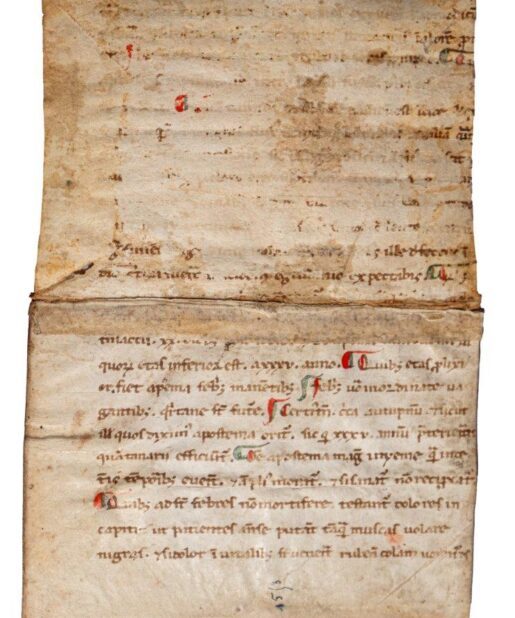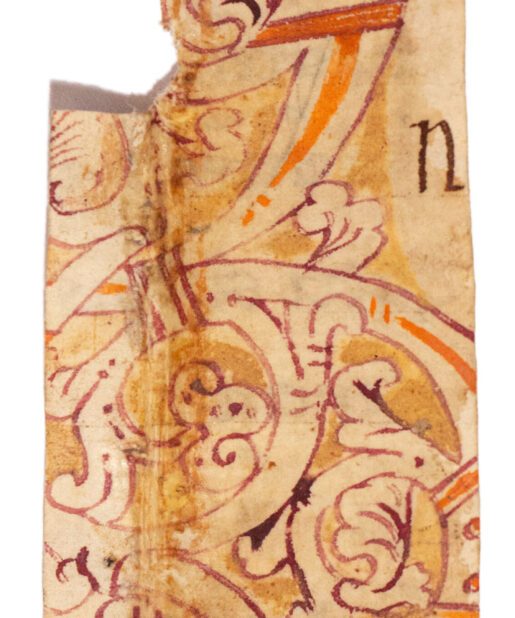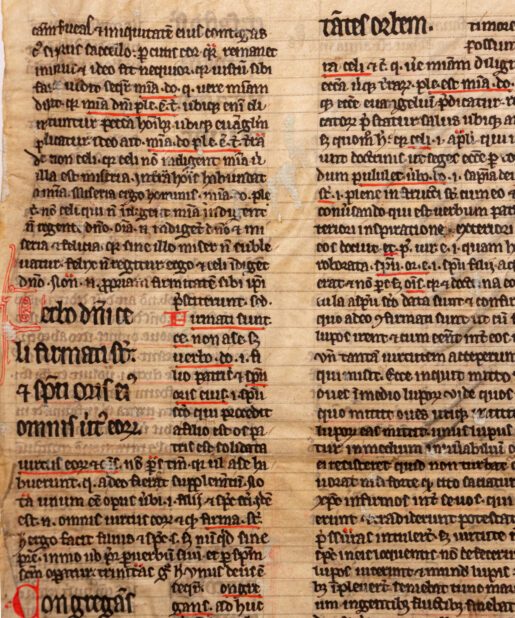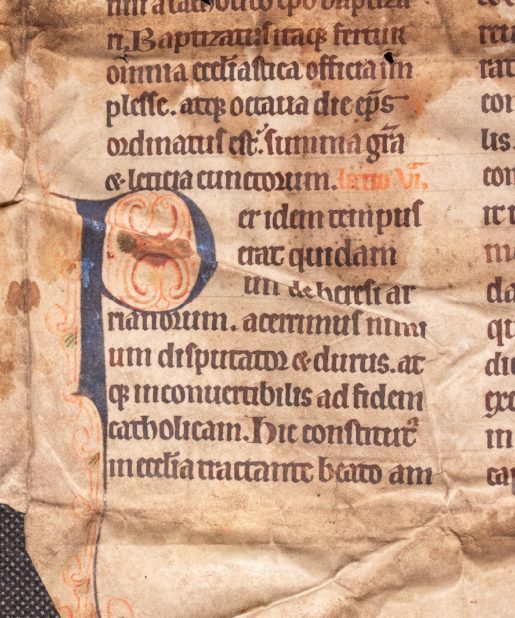One of the earliest Latin manuscripts of Hippocrates c.1175, France – the Prognostics 2 leaves.
£0.00
Out of stock
Hippocrates (c. 460 – c. 370 BC), Prognostics, in Latin, decorated manuscript on parchment [France, 12th century, second half]
Two leaves, c. 151 × 110 mm, each preserving two margins, the other two cropped, with slight cropping of text, written in a single column of 25 (surviving) lines, capitals stroked in red, paraphs alternately green or red, two-line initials alternately green with red touches or vice versa, recovered from use as endleaves in a later binding, each with a horizontal crease across the middle, one half forming a flyleaf and the other a pastedown, with one half of the reverse side (the pasted-down portion) damaged by glue and removal from the binding; but one side of each leaf substantially free of damage and easily legible
Provenance
1.Don Giovanni Bartolo, 15th/16th century: apparently recovered from a rule-book inscribed with his name in cipher: the lower margin of one leaf is inscribed with two lines of apparently gibberish, in which each vowel is replaced by a ‘p’ with a varying number of cross-strokes across the vertical bar (one stroke = ‘a’, two strokes = ‘e’, three strokes = ‘i’, etc.), from which we can decipher the ownership inscription in Italian as ‘Questa regela e di don giouanni bartolo meo’.
2. Recovered from a binding, purchased from Continental auction house.
Text
Originally written in Greek, the text was translated into Latin twice in late antiquity, and then via an Arabic intermediary in the 11th and 12th centuries, by Constantine the African and by Gerard of Cremona (d. 1187), respectively. The original was in 25 sections, and the Latin in three parts: part 1 equivalent to sections 1–7, part 2 equivalent to sections 8–19, and part 3 equivalent to the remainder. The Latin text circulated in several forms in the Middle Ages, including commentaries, paraphrases, and extracts within anthologies; it has not been possible to determine precisely which is represented by the present leaves. A translation into English is available online.
The most easily legible page has large coloured initials ‘F’ in red and ‘S’ in green; the text begins with the end of Prognosticon 1.23 and continues from there: ‘in periplemonia. Frendere dentibus preter solitum … (1.24) Si in egro corpore … ❡ Quod si exicatus …’ (1.25) ❡ Manuum mobilitatis …’, and so on to the next large initial: ‘Sudor bonus & laudabilibus … (1.29)’, continuing overleaf as far as ‘Eorum que intus crepuerit’ (1.45). The other leaf has from ‘… quorum etas inferior est a xxxv anno’ (3.25) to ‘… rubeam coleram vomituros’ (3.31) on the recto, continuing on the more legible verso from ‘Quibus ille dolor in capite a pimordio febris …’ (3.32) to ‘❡ Scito omnes egritudine posse evenire omnibus temporibus’ (3.39).
The significance of these two leaves:
The Arabic translations of Greek philosophical and medical texts, including Avicenna’s works, were brought to Spain by the Moors. This transmission to Spain occurred around the 11th to 12th centuries.
In the twelfth century, Gerard of Cremona, a translator, rendered more than seventy works from Arabic into Latin, including texts from Aristotle, Hippocrates, Galen, and Ptolemy. Learned Jews of Toledo played a role in introducing these translated works to the Western schoolmen around 1150.
The translation of Hippocrates’ works from Arabic into Latin played a significant role in the transmission of medical knowledge from the Arab world to medieval Europe. During the Middle Ages, the Latin West had limited access to the original Greek manuscripts, and much of the classical knowledge was preserved and transmitted through Arabic translations.
Gerard of Cremona, a twelfth-century translator, was instrumental in translating various medical works, including those of Hippocrates, from Arabic into Latin. Gerard of Cremona was an Italian scholar who dedicated much of his life to translating scientific and philosophical texts from Arabic into Latin. His translations contributed greatly to the Scholastic movement and the intellectual revival in Europe.
Regarding the specific translations of Hippocratic works, Gerard of Cremona translated several of them into Latin. Some of the works attributed to Hippocrates that were translated include the “Hippocratic Corpus,” a collection of medical texts traditionally ascribed to Hippocrates. These texts cover a wide range of medical topics, including anatomy, pathology, diagnosis, and treatment.
The translation of Hippocratic texts from Arabic into Latin not only provided Western scholars with access to foundational medical knowledge but also influenced the development of medieval medical thought. The availability of these translated works contributed to the curriculum of medical schools in places like Salerno and Montpellier, where the study of medicine based on Arabic-Latin versions of classical texts became prominent.
Be the first to review “One of the earliest Latin manuscripts of Hippocrates c.1175, France – the Prognostics 2 leaves.” Cancel reply
Product Enquiry
Related products
C12th - C13th manuscripts
C12th - C13th manuscripts
A Romanesque white-vine initial with a zoomorphic design and gorgeous script, C12th.
C12th - C13th manuscripts
Miniature Breviary leaf with unusual and handsome script, c.1280
C12th - C13th manuscripts
C12th cutting with remains of a coloured initial, Carolingian Lectionary
C12th - C13th manuscripts
Glossed Bible leaf reused as a binding in French archive. France (doubtless Paris), 13th century.
C12th - C13th manuscripts
C12th - C13th manuscripts
Elegant English Early Gothic Script from late C12th Passionale – Paulinus of Milan













![[Bible] C13th the Book of Lamentations ch.1-3 in a minuscule and heavily abbreviated script on parchment. England, c.1250-75 [Bible] C13th the Book of Lamentations ch.1-3 in a minuscule and heavily abbreviated script on parchment. England, c.1250-75](https://butlerrarebooks.co.uk/wp-content/uploads/2023/05/IMG_9289-scaled-515x618.jpg)






![Cuttings from a Romanesque copy of Priscian Institutiones Grammaticae, in Latin with a single word in Greek, manuscript on parchment. [Germany, 12th century]. Cuttings from a Romanesque copy of Priscian Institutiones Grammaticae, in Latin with a single word in Greek, manuscript on parchment. [Germany, 12th century].](https://butlerrarebooks.co.uk/wp-content/uploads/2023/05/IMG_9986-scaled-515x618.jpg)
![Cuttings from a Romanesque copy of Priscian Institutiones Grammaticae, in Latin with a single word in Greek, manuscript on parchment. [Germany, 12th century]. Cuttings from a Romanesque copy of Priscian Institutiones Grammaticae, in Latin with a single word in Greek, manuscript on parchment. [Germany, 12th century].](https://butlerrarebooks.co.uk/wp-content/uploads/2023/05/IMG_9981-scaled-515x618.jpg)






Reviews
There are no reviews yet.